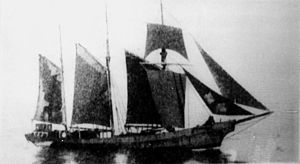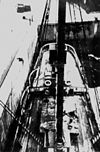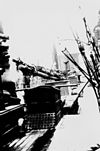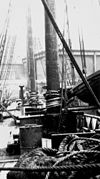- Mary B Mitchell
-

Career (United Kingdom) 
Name: Mary B Mitchell Owner: William Thomas Port of registry: Anglesey Launched: 1892 Commissioned: 1893 In service: 1893-1916 Fate: Requisitioned Career (United Kingdom) 
Name: Mary B Mitchell Commissioned: 5 May 1916 In service: 1916-1919 Notes: Converted to Q-ship at HMNB Falmouth Career (Ireland) 
Name: Mary B Mitchell Port of registry: Arklow In service: 1919-1944 Fate: Wrecked 20 December 1944 General characteristics Type: Q-ship Tonnage: 227 gross tons[1] Propulsion: sail + auxiliary motor Armament: 1 ×12 pounder naval gun,
2 × 6 pounder guns,
2 × Lewis gunsThe Mary B Mitchell was a British schooner which served as a Q-ship during the First World War. She was in service from April 1916 until the end of hostilities, operating in the Southwest Approaches from her base in Falmouth. She had five encounters with German U-boats in her career, and was credited with the destruction of two.Post-war analysis established that no U-boats were sunk.[2] She had a reputation for being an efficient and successful vessel. After the war she returned to merchant service but was wrecked in 1944.
Contents
Early career
Mary B Mitchell was built in 1892 at Carrickfergus, as a three-masted topsail schooner. She started her career exporting slate from North Wales to Hamburg. She was owned by Lord Penrhyn and served for a period as a yacht, before being put to work as a coaster,[3] transporting china clay from Cornwall. In 1916 three Arklow schooners were requisitioned by the Admirality to be used as Q-ships, they were: Cymric, Gaelic and Mary B Mitchell.
Service history
In April 1916 she was at Falmouth, where she was requisitioned for service as a Q-ship. She was armed and outfitted, under the command of Lt. M Armstrong RNR, to carry a 12-pounder and two 6-pounder guns as well as two machine guns and small arms.[4] She commissioned on 5 May 1916 and sailed on her first patrol on 26 June, returning to Falmouth on 25 July. During this period she sailed the usual sea routes in the Channel and the Southwest Approaches, masquerading as a merchant ship and inviting attack by a German U-boat. Over the following months she undertook a series of such patrols, in a variety of disguises. Great success was claimed[5]
On 20 June 1917, under the command of Lt J Lawrie and in the guise of the French schooner Eider, she encountered a U-boat sailing west of Brittany, which approached and opened fire. Mitchell carried out her role as a decoy, being hove to and abandoned until he U-boat was within 600 yards, when she returned fire scoring several hits. At this the U-boat dived and was not seen again.[6] The U-boat, later identified as UC-65, was not damaged. That evening, Mitchell had a further encounter, which unfolded in the same way, though on this occasion the U-boat was more wary, and Mitchell's crew had a more difficult time before scoring hits on their assailant.[7] This U-boat, UC-17, was also not damaged.
On 3 August 1917 Mitchell had her third encounter, sailing south of Start Point in the guise of the French schooner Cancalais. She encountered a U-boat, UC-75, which approached, opening fire at a range of nearly three miles. Mitchell's crew again hove to and the panic party abandoned ship, while the gun crews waited for their target to come into range. However the U-boat was too cautious, and after being shelled for fifteen minutes, Lawrie elected to clear away and close under engine power. Mitchell was able to score some hits before the U-boat disappeared, but no loss was confirmed. For these actions Lawrie was awarded the DSO.[8]
After the war, it was concluded that Q-ships were greatly over-rated, diverting skilled seamen from other duties without sinking enough U-boats to justify the strategy.[9]
Later career
Mary B Mitchell was decommissioned in 1919 and returned to James Tyrrell of Arklow. She had a long eventful career surviving into the Second World War.
Mary B Mitchell appearred as the doomed Mary Celeste in the film The Mystery of the Marie Celeste, which was released in the U.S. as The Phantom Ship (1935),[10] one of the early films from Hammer Film Productions. She featured in the 1936 film McGlusky the Sea Rover.[11]
In December 1944 she was wrecked in a gale in the Solway Firth and written off.
World War Two
At the outbreak of World War II there were only 56 ships on the Irish register, 14 of those were Arklow schooners. These schooners played a vital role in keeping Ireland supplied.[12] Mary B. Mitchell carried food exports and pit props to Wales; returning with cargoes of coal.
In 1943 she went on the hazardous “Lisbon run”. American ships would not enter Irish waters;[13] they brought Irish-bound cargoes to Lisbon. Ships like the Mary B. Mitchell had to collect them. Britain had declared the Bay of Biscay to be an “exclusion zone”; their objective was to prevent supplies from reaching Germany, in particular Japanese exports. However Britain needed foreign currency, which she could obtain by exporting coal to Portugal. ‘Navicerts’ were introduced. Ships with a navicert were permitted safe passage through allied lines. They were to follow the line of longitude at 12° west.[14] Allied convoys to Gibraltar were at least 20° west to avoid the range of German bombers. However, it was difficult for sailing ships to adhere to this straight line, particularly in the stormy conditions, common in the Bay of Biscay.
Mary B. Mitchell made five of these voyages, carrying food to Britain, then British coal to Lisbon, returning with the American cargo to Ireland. Arthur Dowds was captain James Harte was sailing master and Patrick Brennan was first officer. She survived these hazardous journeys. Cymric, another Arklow schooner, which had also been requisitioned as a Q-ship in World War One, was not as fortunate. She vanished with all hands; she may have hit a mine, been torpedoed by a U-boat or bombed by the RAF, as was the MV Kerlogue on this same route.
In preparation for D-day, Britain withdrew navicerts in April 1944. At this time there was a severe shortage of fuel in Ireland. Gas rationing was introduced and there was severe curtailment of rail services. The Minister for Supplies instructed the Arklow schooners to cease other imports and only to import coal. The schooners averted a possible great hardship that winter. By the autumn they had imported 40,000 tons of coal, while bringing food supplies to Britain.[15]
Mary B. Mitchell left Dublin for the last time on 13 December 1944; she was bound for Cumberland with a cargo of burnt-ore. She was to return with a cargo of coal. In a storm she was driven onto rocks at the entrance to Kirkcudbright Bay, and lost. Captain Patrick Brennan and his crew of eight were taken off by Kirkcudbright lifeboat, all survived. Some items from ship are on display in the Stewartry Museum. Some wreckage remains at the base of the cliff near Senwick Church.[16]
Commemoration
The Mary B Mitchell is commemorated in Bangor, Wales, by a memorial plaque and a bronze weathervane which adorns the city’s new shopping precinct. It was designed and made by Ann Catrin Evans and Roger Wyn Evans. The plaque gives a brief account of the ships history, while the weathervane depicts her in silhouette.
Notes
- ^ Ritchie p189
- ^ Forde page14
- ^ Ritchie p8
- ^ Ritchie p97
- ^ "Mary B Michell - A Terror to U-boats". Daily Leader. Associated Press: p. 7. 13 January 1919. http://www.newspaperarchive.com/SiteMap/FreePdfPreview.aspx?img=101288063. Retrieved 19 November 2011. "Sailing vessel sank two submarines in one day during the war"
- ^ Chatterton p72
- ^ Chatterton p73
- ^ Chatterton p74
- ^ Preston, Anthonu (1982). Submarines. London: Bison Books. p. 58. ISBN 086124043X.
- ^ Lugosi: His Life in Films, on Stage, and in the Hearts of Horror Lovers. McFarland. 2006. p. 108. ISBN 9780786427659. http://books.google.com/books?id=E4hflza6Jo4C&pg=PA108.
- ^ Forde, Maritime Arklow, p52
- ^ "From Sail to Steamship". Follow the Fleet. Irish Maritime Development Office. 2007. http://www.imdo.ie/followthefleet/fleetFromSail.asp. Retrieved 19 November 2011. "Two famous sailing ships Cymric and Mary B. Mitchell, brought vital supplies from overseas during the war years."
- ^ Burne, Lester H (2003). Richard Dean Burns. ed. Chronological History of U.S. Foreign Relations: 1932-1988. 2. Routledge. pp. 537. ISBN 9780415939164.
- ^ Forde, (2000). The Long Watch, page ii.
- ^ Forde, The Long Watch, p20
- ^ Collin, David (2002.). "General Histories". The Mary B. Mitchell. Kirkyards Website Project Team. http://www.kirkyards.co.uk/historyarticle.asp?ID=148&p=23&g=5. Retrieved 19 November 2011.
References
- Chatterton, E Keble : Q-Ships and their story. (1922) ISBN (none)
- Ritchie, Carson : Q-Ships. (1985) ISBN 0 861138 011 8
- Forde, Frank (1981, reprinted 2000). The Long Watch. Dublin: New Island Books. ISBN 1 902602 42 0.
- Forde, Frank (1988). Maritime Arklow. Dún Laoghaire: Glendale Press. ISBN 0907606512.
External links
- Noonan, Dix. "Lot 1244, 7 Dec 05". Lot details. http://www.dnw.co.uk/medals/auctionarchive/searchcataloguearchive/itemdetail.lasso?itemid=50402. Retrieved 18 November 2011. "quoting London Gazette 16 February 1917, and 11 August 1917"
Categories:- Q-ships of the Royal Navy
- 1892 ships
- Maritime history of Ireland
- Independent Ireland in World War II
- Merchant marine
Wikimedia Foundation. 2010.



